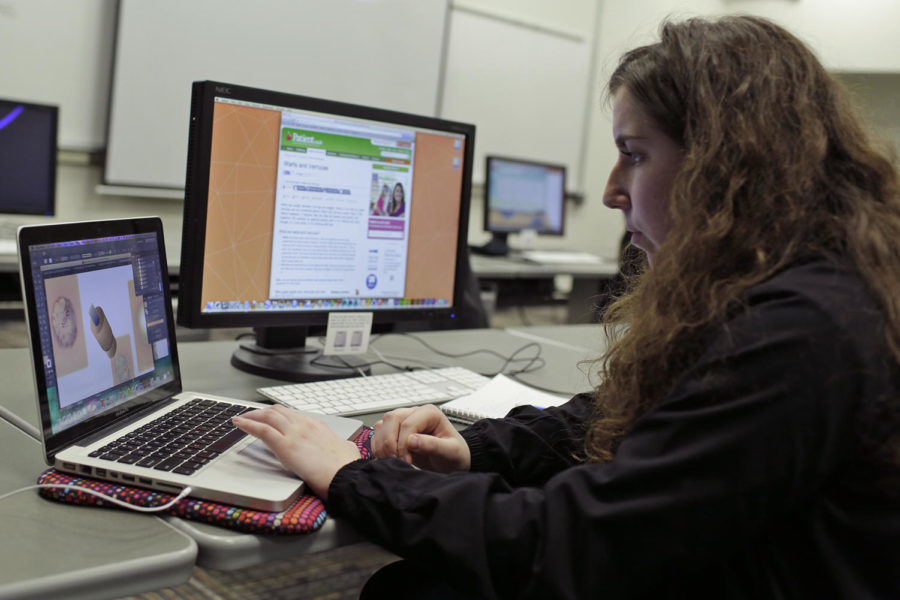Communicating science through art: Students find best of both worlds with BPMI major
February 7, 2014
Before college, students interested in both art and science thought they needed to choose either one or the other for a career.
Iowa State offers students the best of both worlds with a biological pre-medical illustration major that has been around for 30 years. Iowa State is one of roughly 10 universities in the nation that offers this program.
Sixty students at Iowa State are part of the BPMI program, and they can move on to jobs like freelance or certified medical illustrators.
“The level of students graduating [over the last 30 years] has advanced tremendously,” said John Dorn, a lecturer of integrated studio arts. “We are placing, arguably, over 50 percent of our students in grad schools for medical illustration.”
Students begin in the pre-BPMI major to ensure it is the program that fits them. They can then create a portfolio for entrance into the BPMI major.
BPMI is a major that incorporates students’ artistic skills with their interests in medicine. This unique major can range from traditional diagrams in textbooks to digital animations of physiological processes occurring in the human body.
Students don’t just illustrate human physiological processes, though. They can also focus on animals and insects.
Digital animations help people better understand bodily functions.
Amanda Miller, sophomore, was originally applying to only art schools. Her interest was first sparked once she discovered the possibility of a scientific illustration minor at Savannah College of Art and Design. Then she found Iowa State’s BPMI program.
“I want to work on the digital side, make animations and just be able to help patients and students better understand complex ideas,” Miller said.
One of the projects she is currently working on for her BPMI 326 class involves the process of eliminating a wart. Her animations display what the wart looks like before and after treatment.
Miller plans to apply to all four graduate schools in North America.
Another student involved with digital animation is senior Caitlin Swanberg.
With a strong interest in digital art, Swanberg dedicates her time to working for a college professor and an Ames schoolteacher to produce short animations that help to answer questions students have in high school biology classes.
“Illustration is all about understanding what you’re looking at,” Swanberg said.
Swanberg currently has an interview with Johns Hopkins University in Maryland for graduate school.
Not only do these students produce digital graphics throughout their work, they also learn how to create 3-D models. For example, prosthetics such as an ear designed for a child who was born without one can be created by BPMI majors.
Laura Ekl, sophomore, leans more toward the concrete illustration aspect of the major.
“People tend to think that all we do is draw or paint,” Ekl said. “But with where the field is going now, all the jobs are completely digital, so we’re moving away from traditional media.”
Ekl plans on furthering her school career after ISU at the University of Illinois at Chicago in hopes of one day being able to scrub into the operating room and create surgical sketches.
Lynn Clark, professor of ecology, evolution and organismal biology, said the strength of the program has remained constant by managing to keep up with all of the new and improved digital techniques.
Dean Biechler, a lecturer who’s been with the BPMI program all 30 years, said the quality of the students has improved over the years because they have progressively gotten more artistic and science-oriented.
The improvements come with a large amount of outside work that students can bring back into their studios, which takes up much of their time.
“The time commitment of these students is impressive,” Dorn said. “It should almost be considered a double major.”
Ekl said surgical sketching is what she wants to do with her life and that she’ll commit herself to being good at it despite the time commitment.
Despite how time-consuming the major is, it remains the best of both worlds for students interested in both art and science.
“It’s not like you can only like biology,” Swanberg said. “You have to really love the art side of it, too, otherwise you won’t enjoy having to juggle both sides of it. But if you do like both, it’s a really cool community to be in.”







